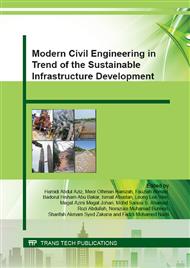p.107
p.112
p.118
p.124
p.130
p.136
p.142
p.149
p.155
Effect of Diameter on Fire Exposed Concrete-Filled Double Skin Steel Tubular (CFDST) Columns under Concentric Axial Loads
Abstract:
Concrete-filled double skin steel tubular (CFDST) columns with three different diameters were exposed to fire following ASTM E-119 fire curve. The temperature was kept constant for 60 minutes after reaching 600°C. After the cooling down process, the columns were tested under concentric axial load condition until failure. Maximum loads, displacement and strain were recorded during testing. Failure patterns were observed. In this paper, failure patterns, increment or reduction of residual strength, ductility and stiffness are reported and discussed in details. All tested CFDST columns failed by local buckling and crushing of concrete. As expected, residual strength index (RSI) decreased with increased fire exposure time. Whereas, larger diameter heated specimen retain more than 50% of it corresponding room temperature secant stiffness. In addition, ductility index (DI) of larger diameter specimen shows an enhancement after fire exposure. Highest enhancement in DI was observed in 90 minutes fire exposure.
Info:
Periodical:
Pages:
130-135
Citation:
Online since:
October 2015
Authors:
Price:
Сopyright:
© 2015 Trans Tech Publications Ltd. All Rights Reserved
Share:
Citation:


